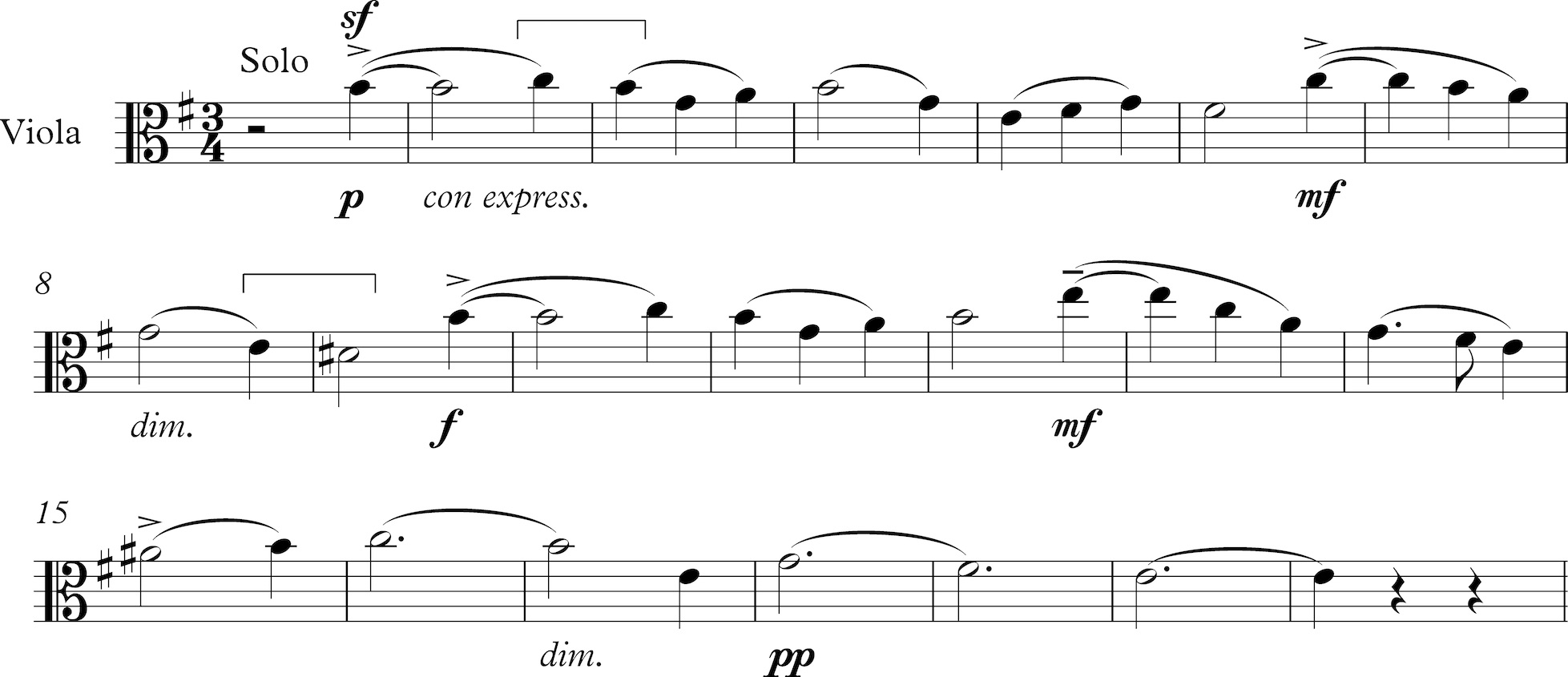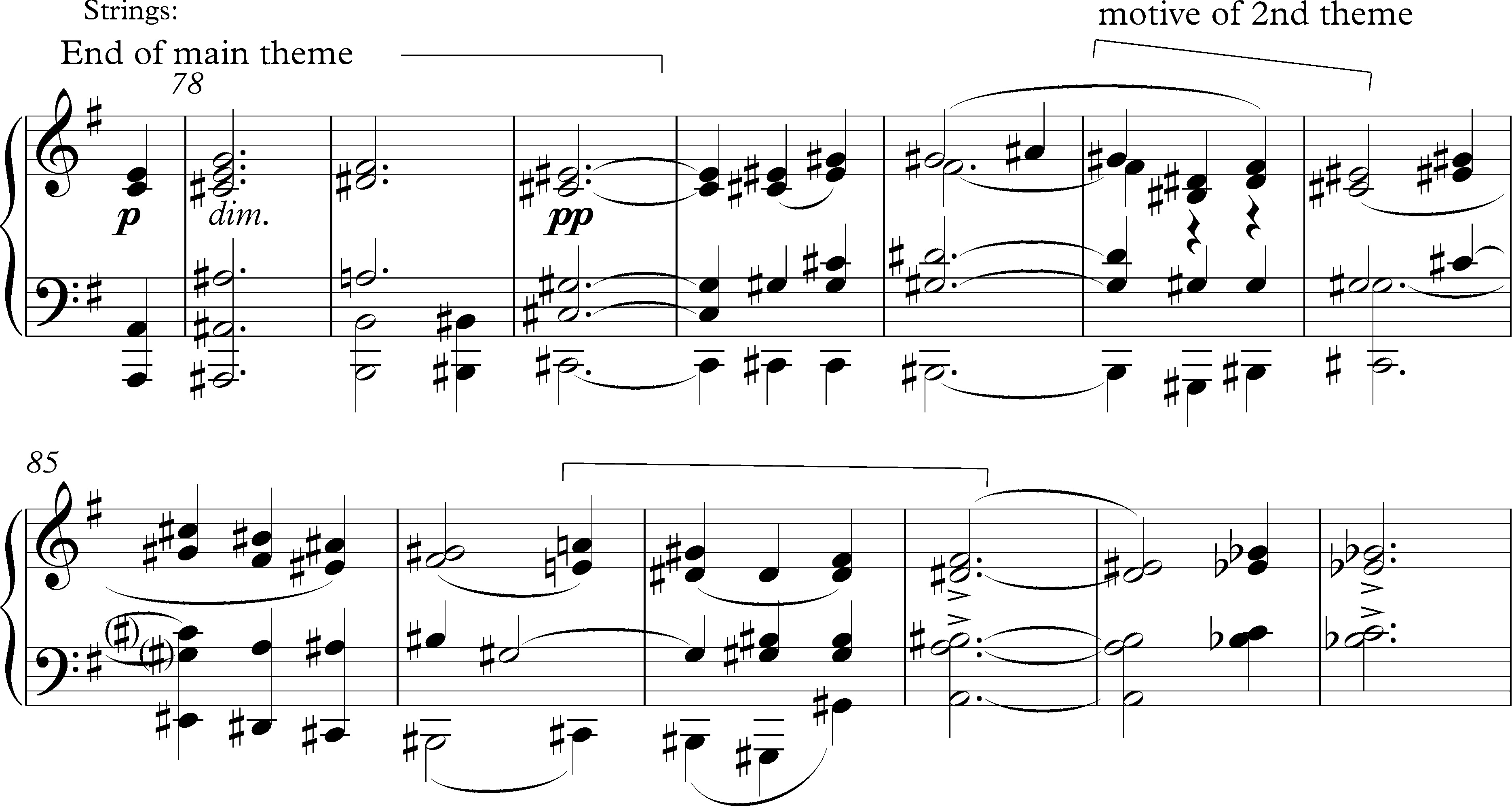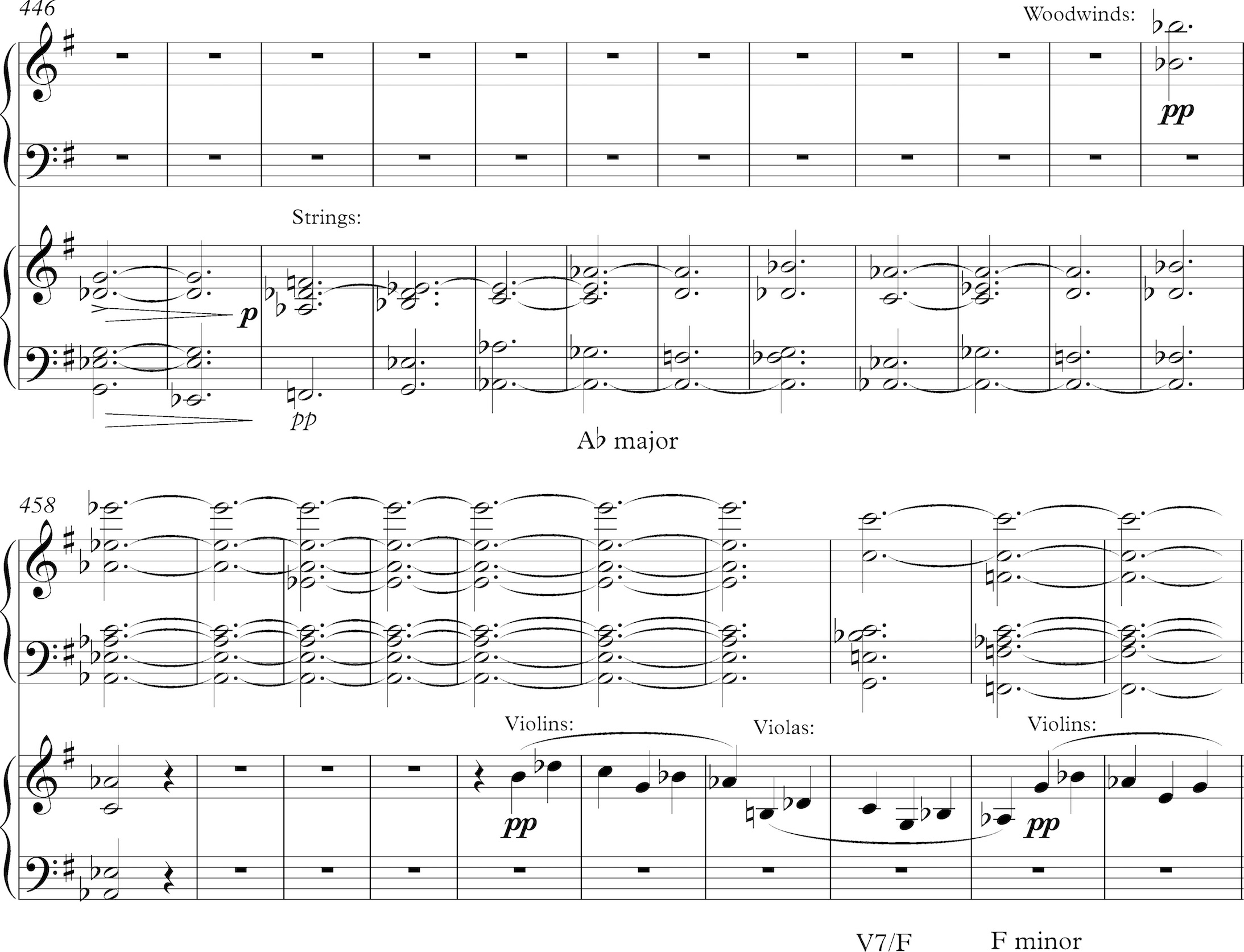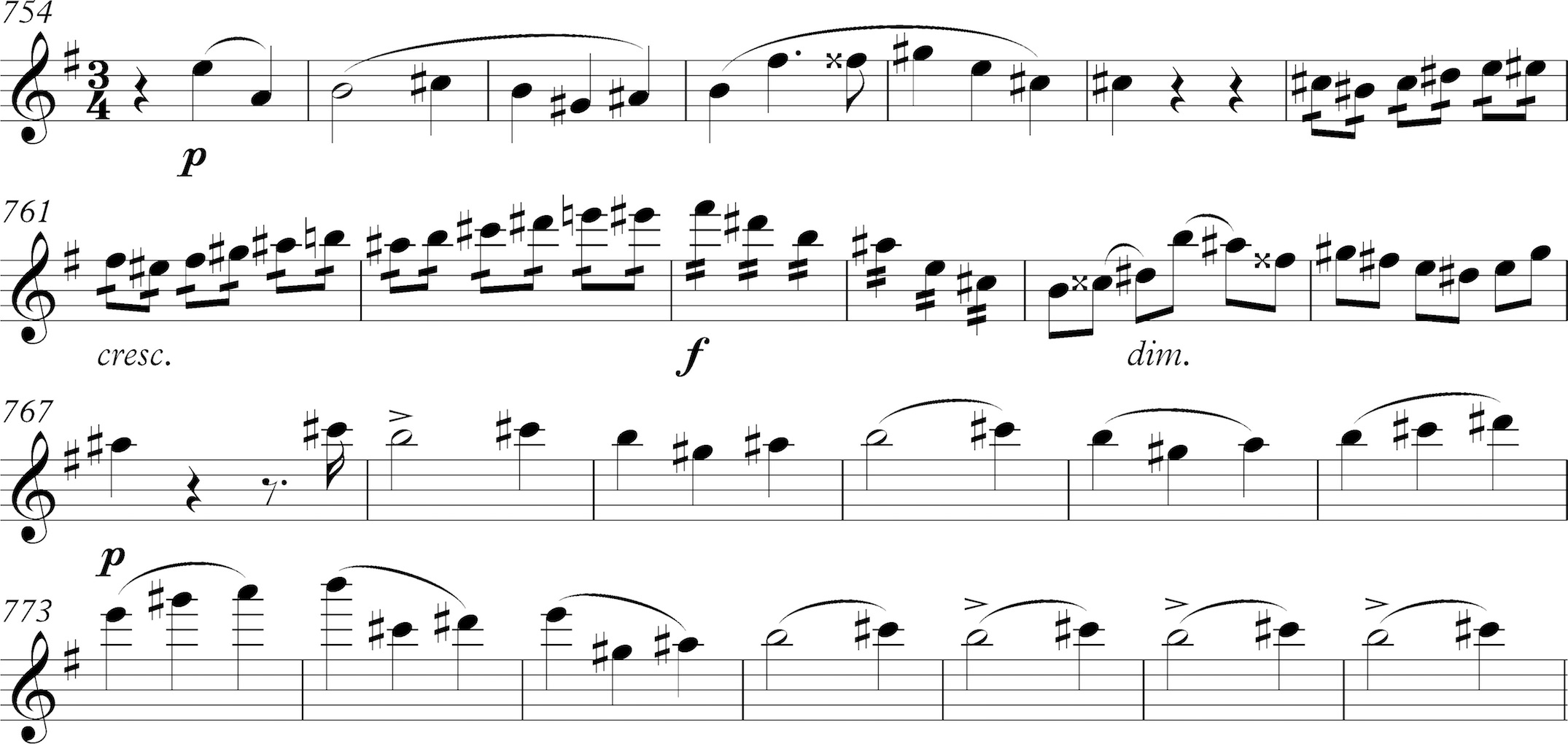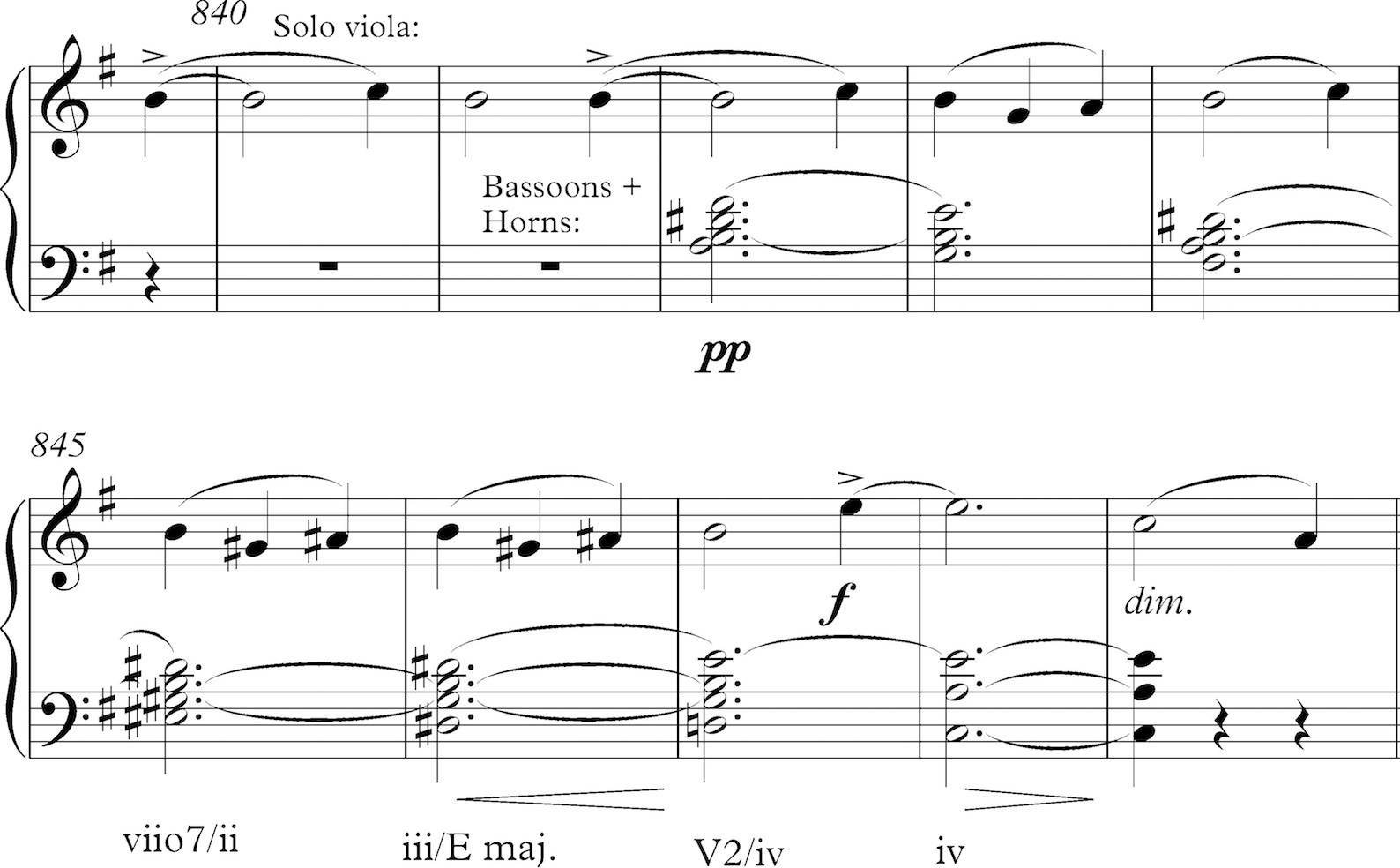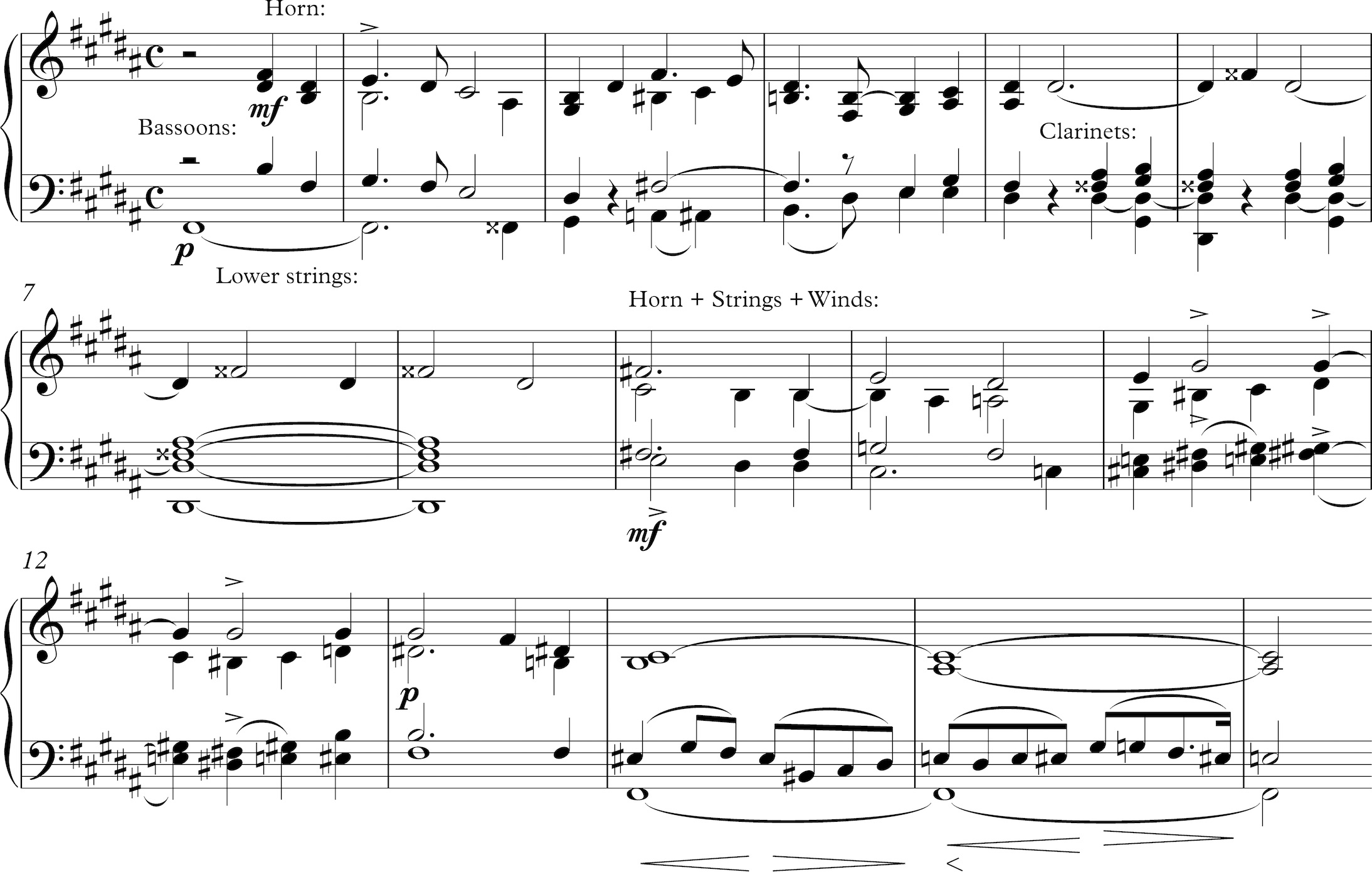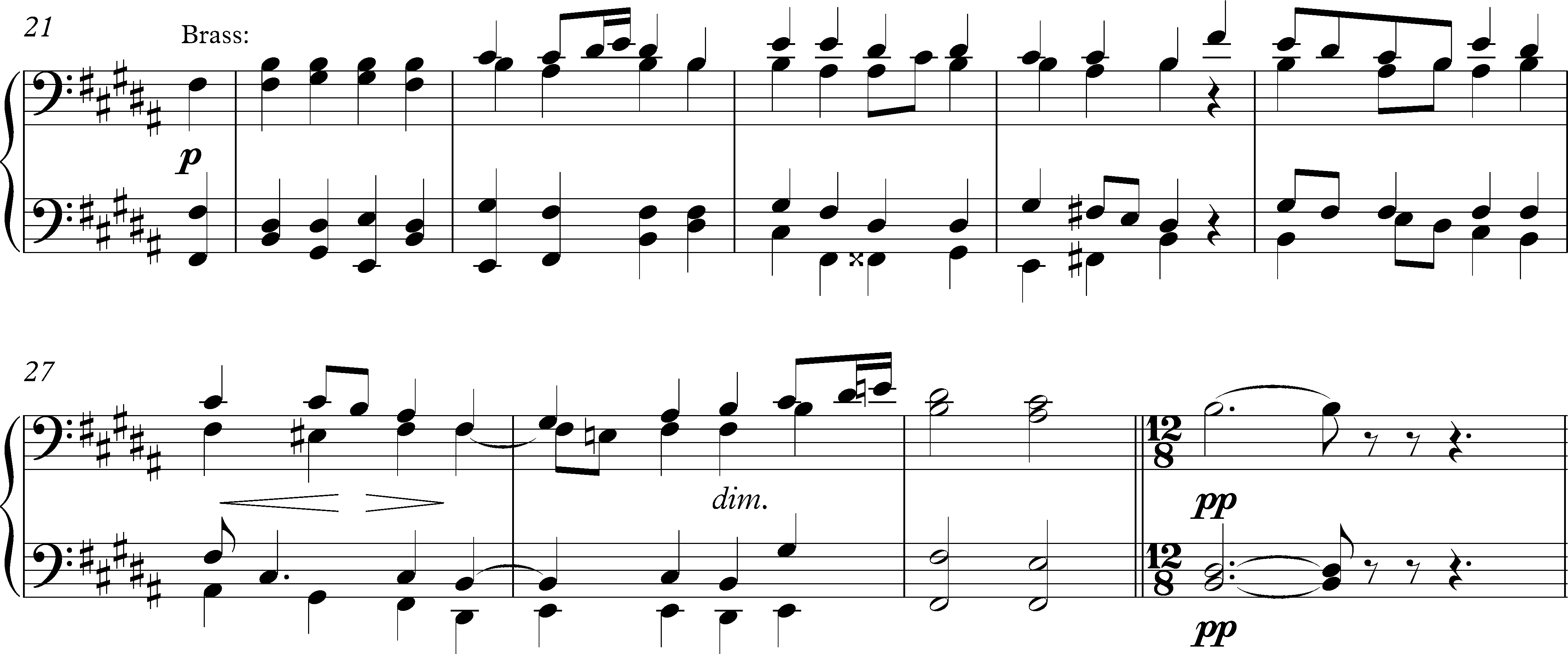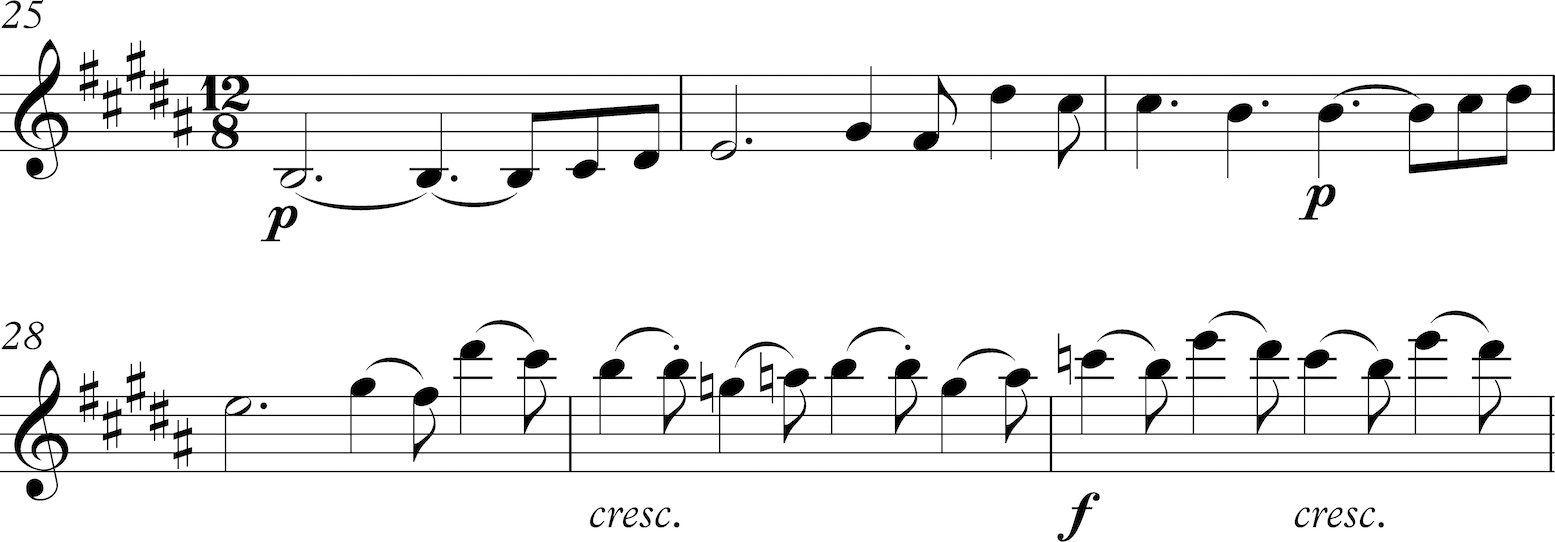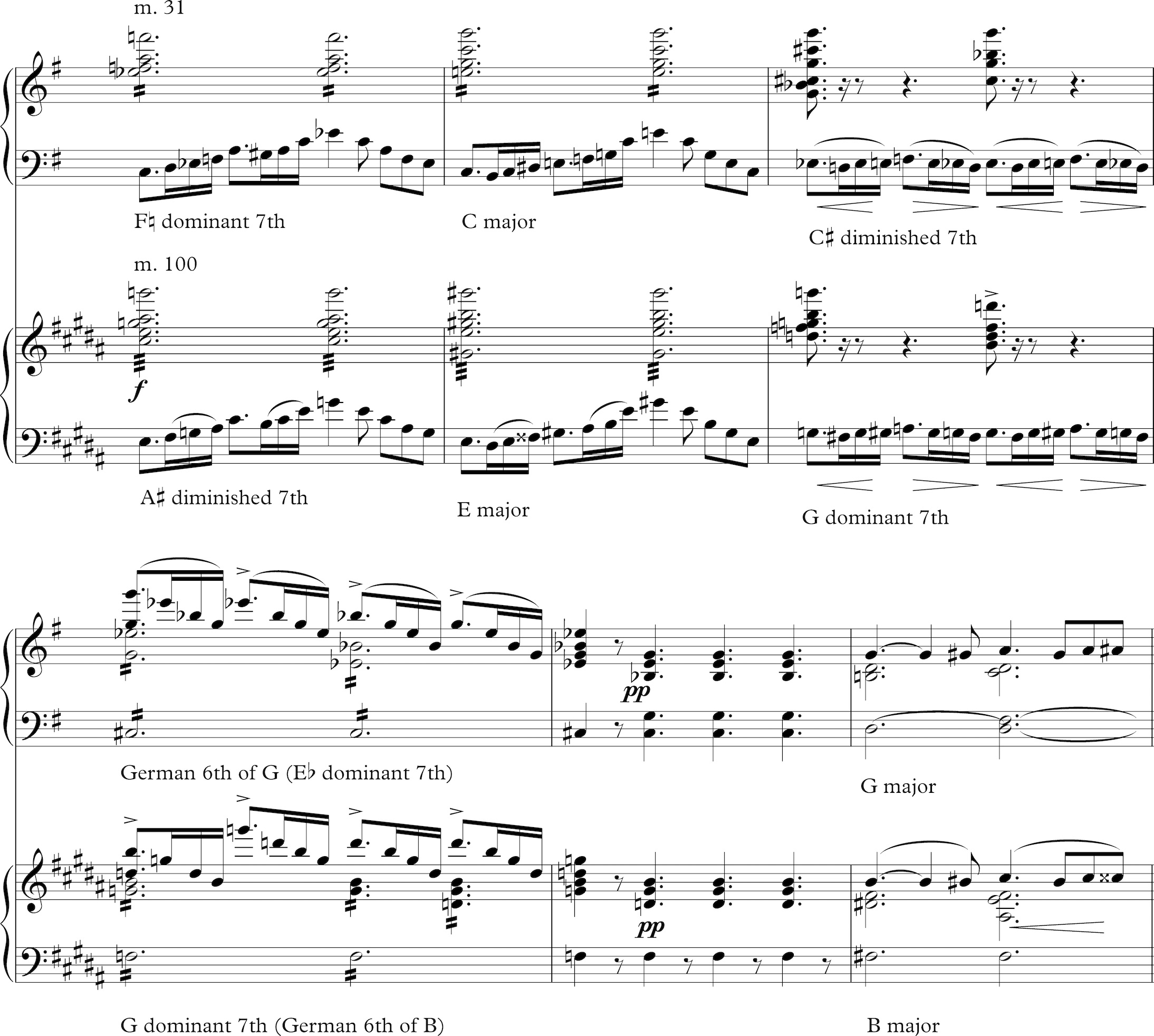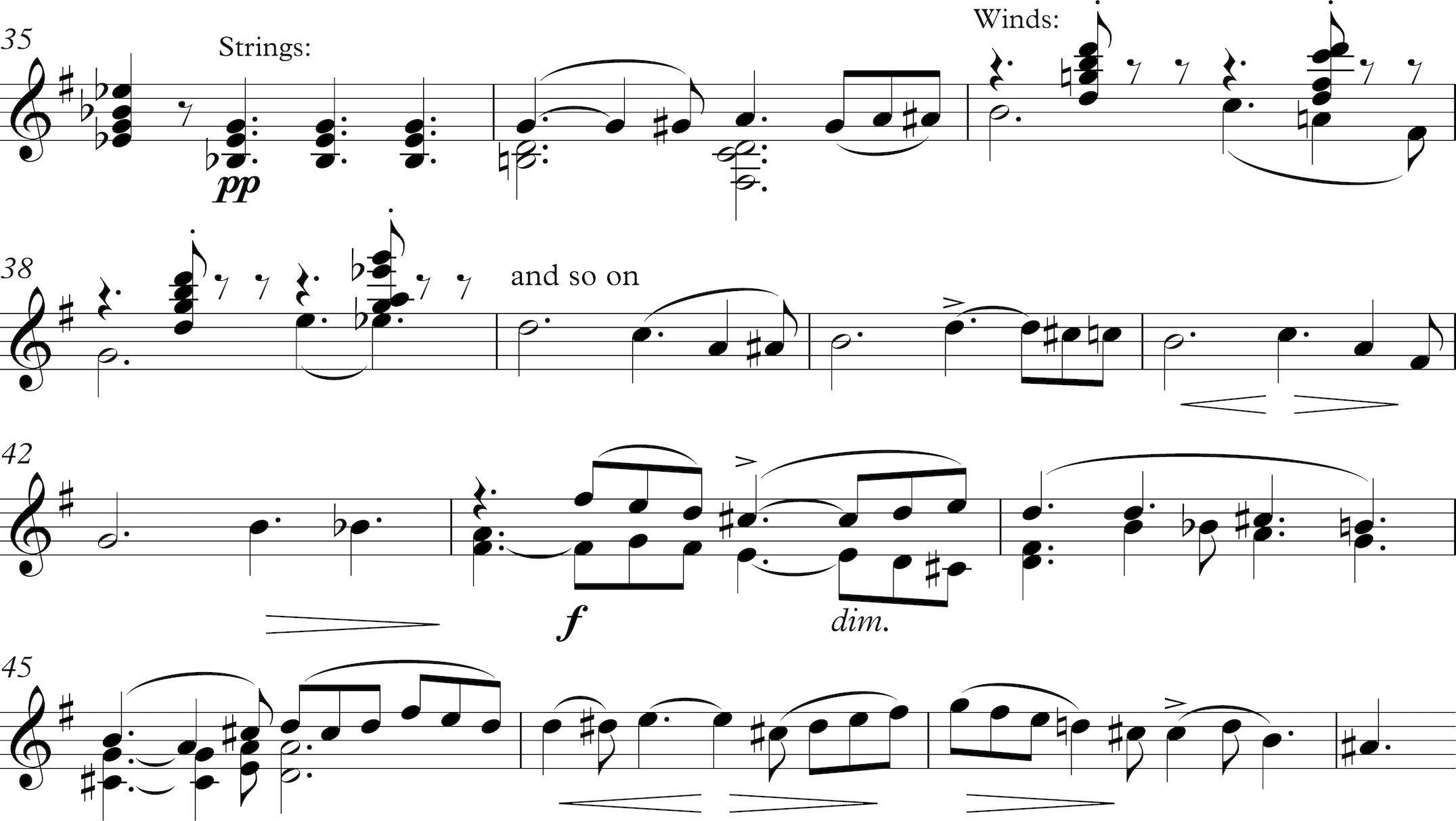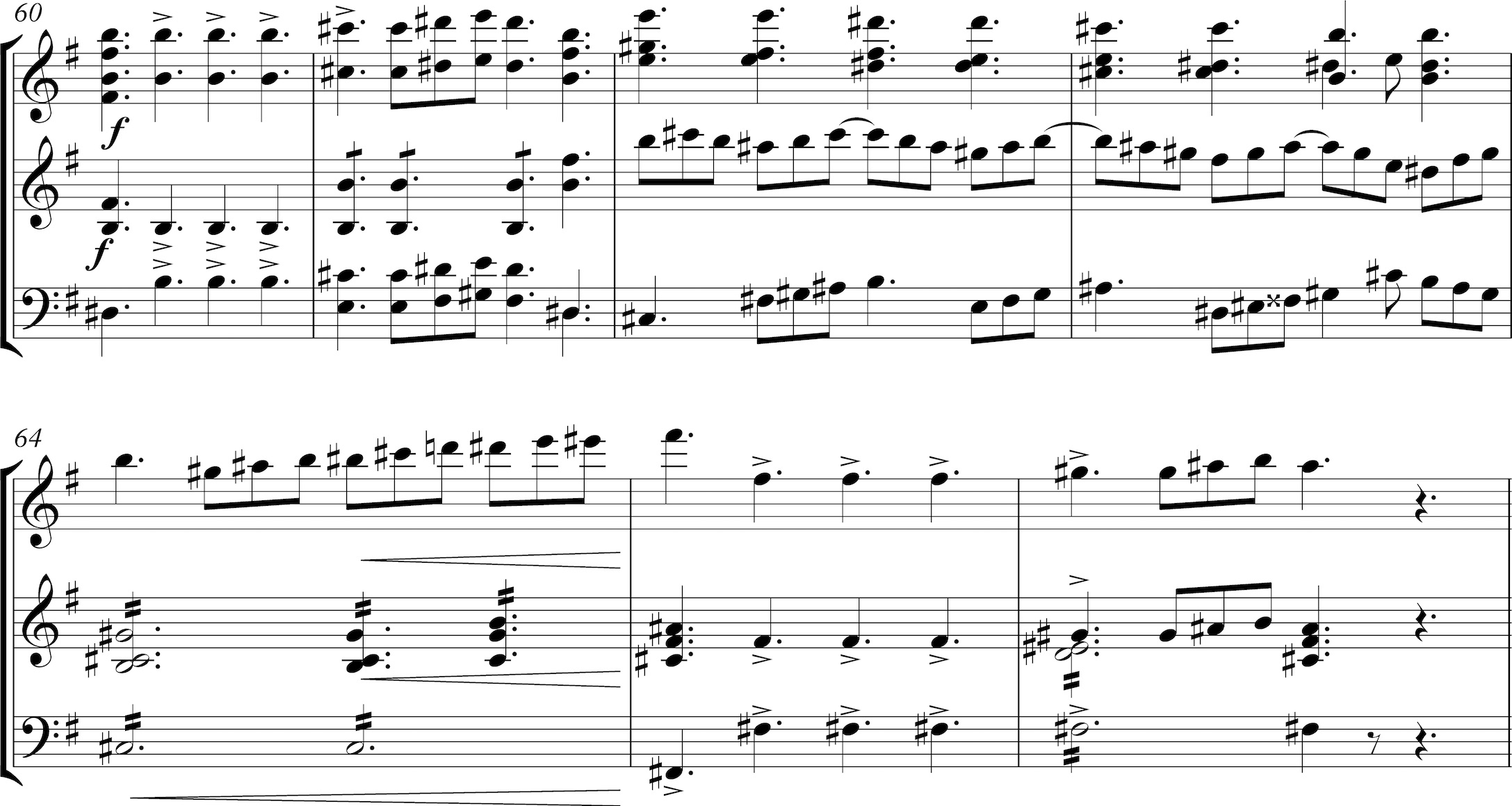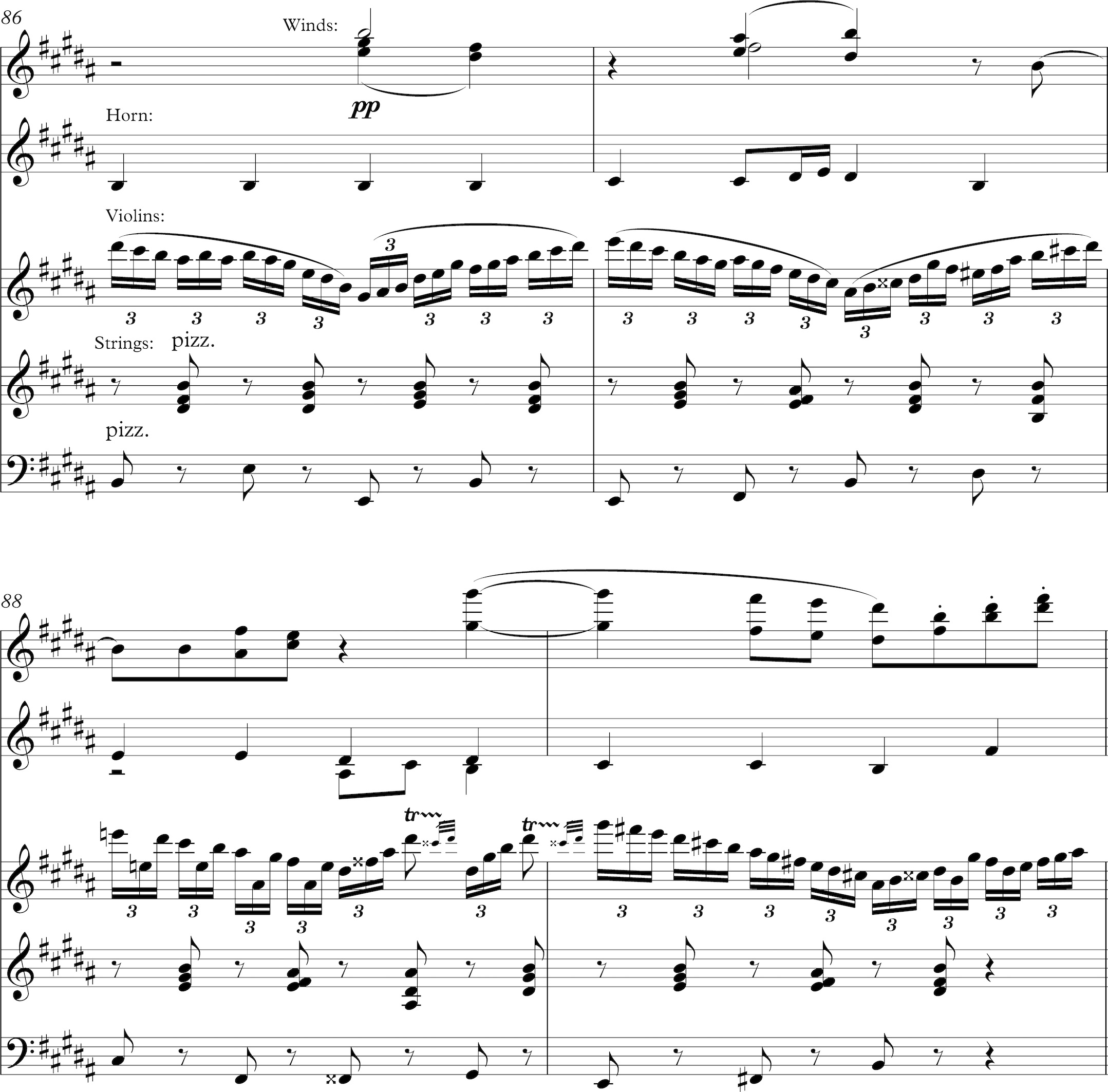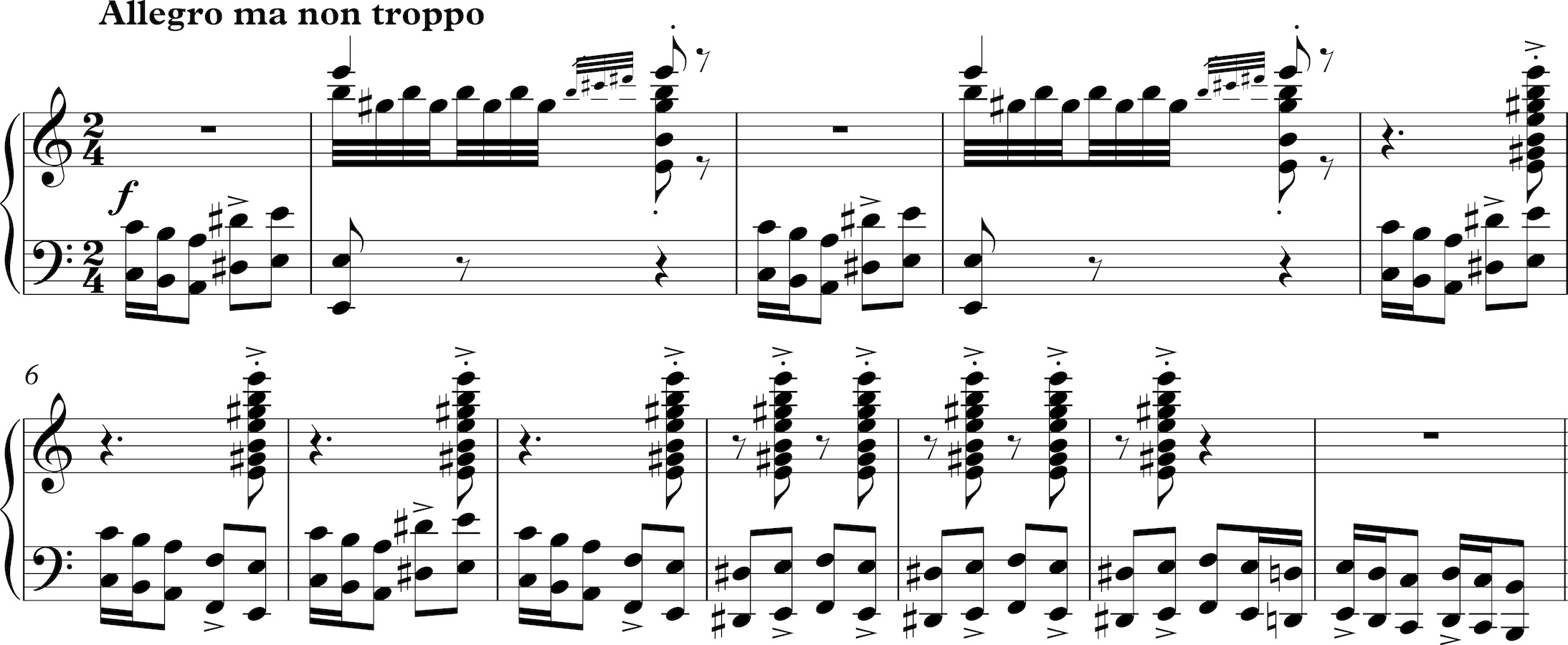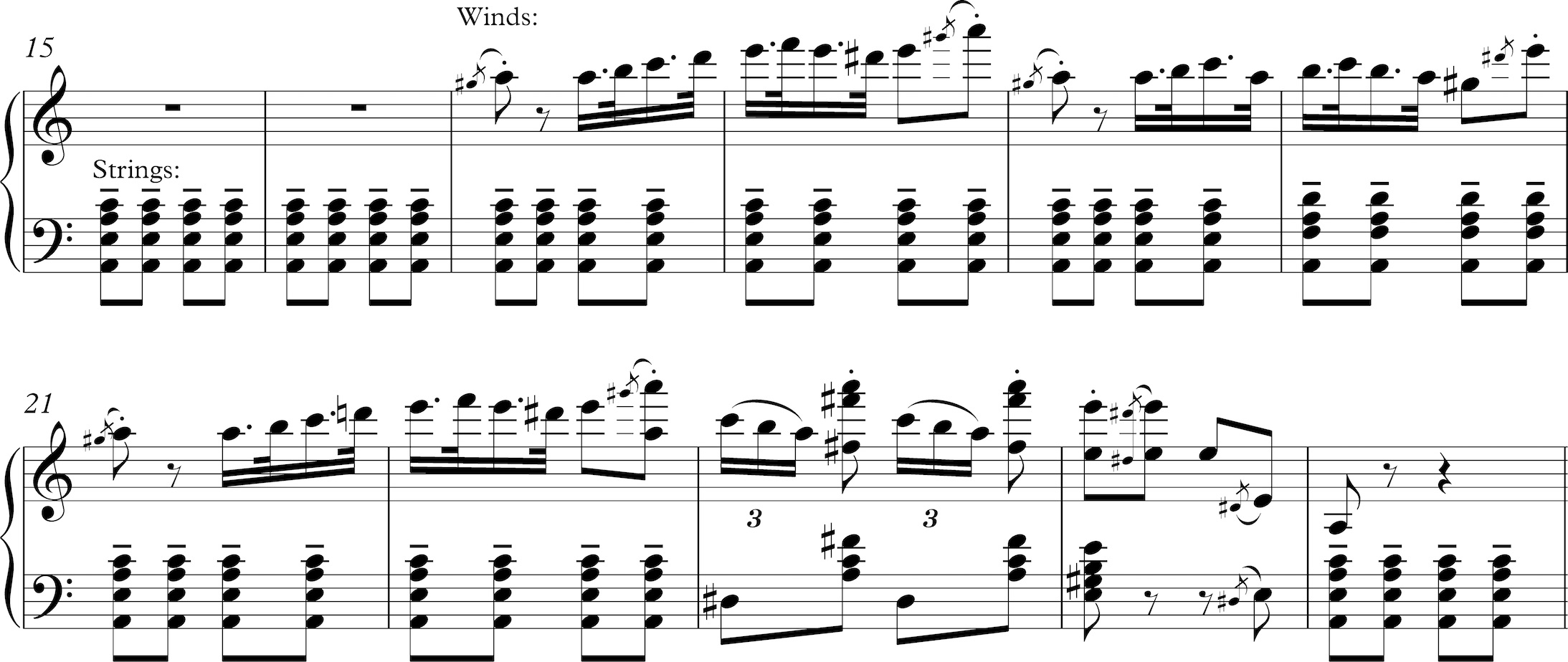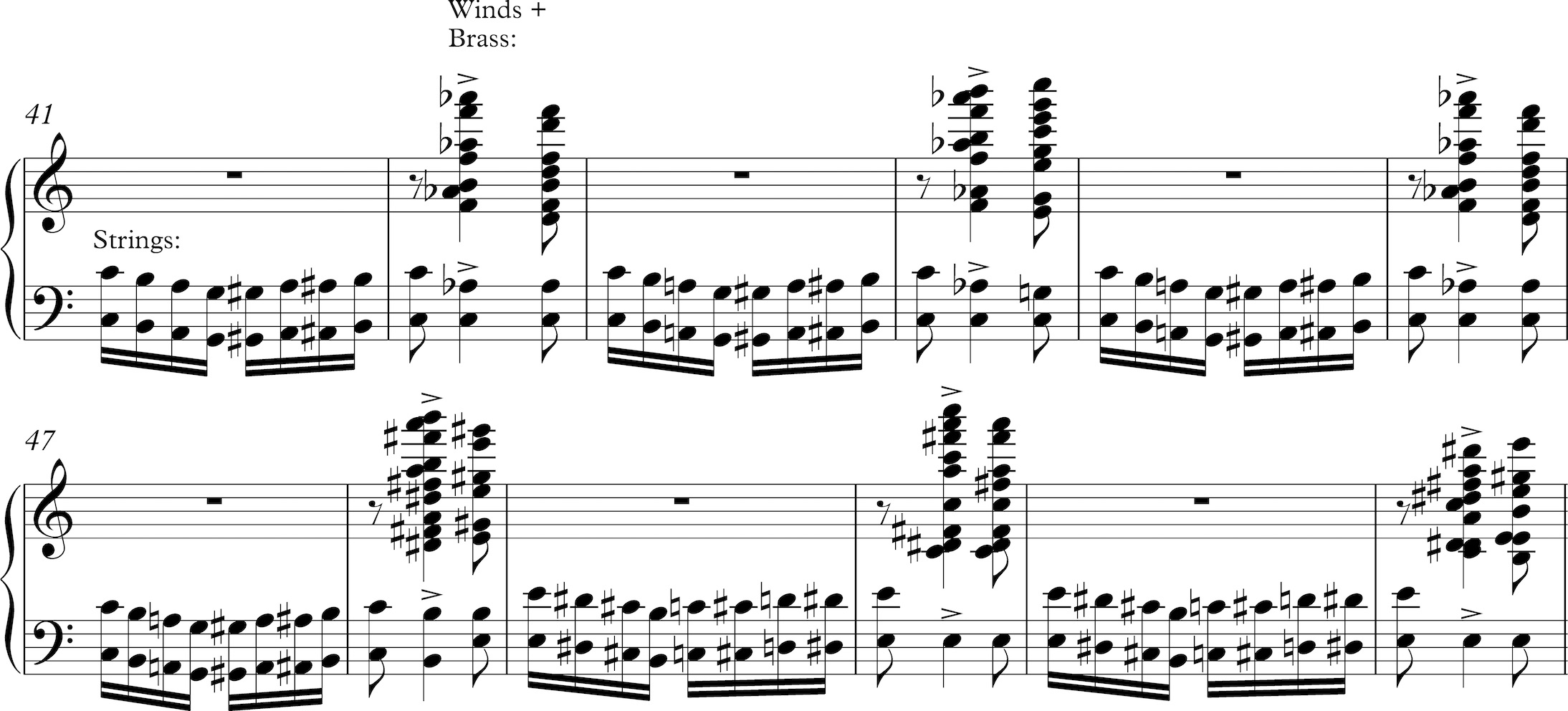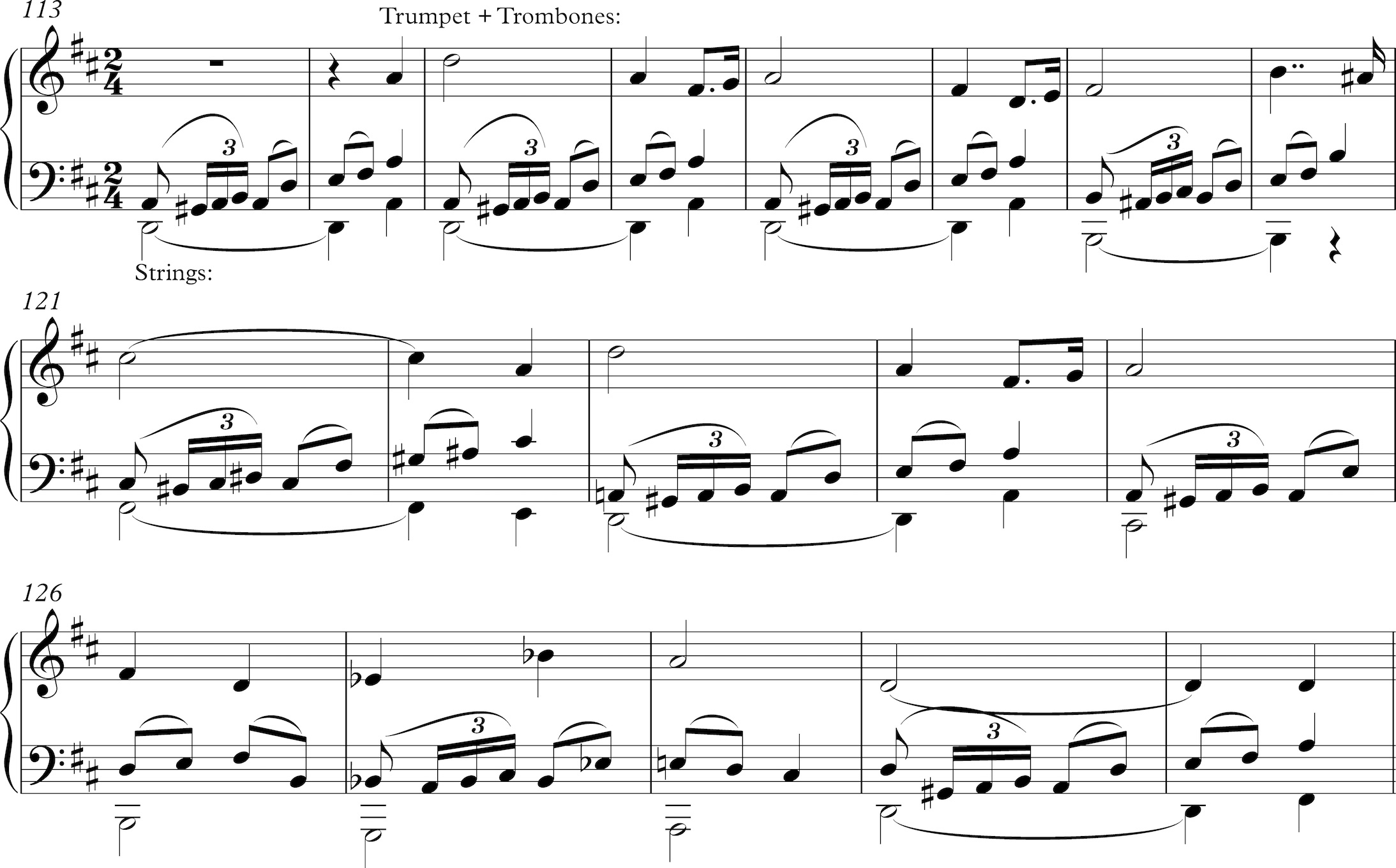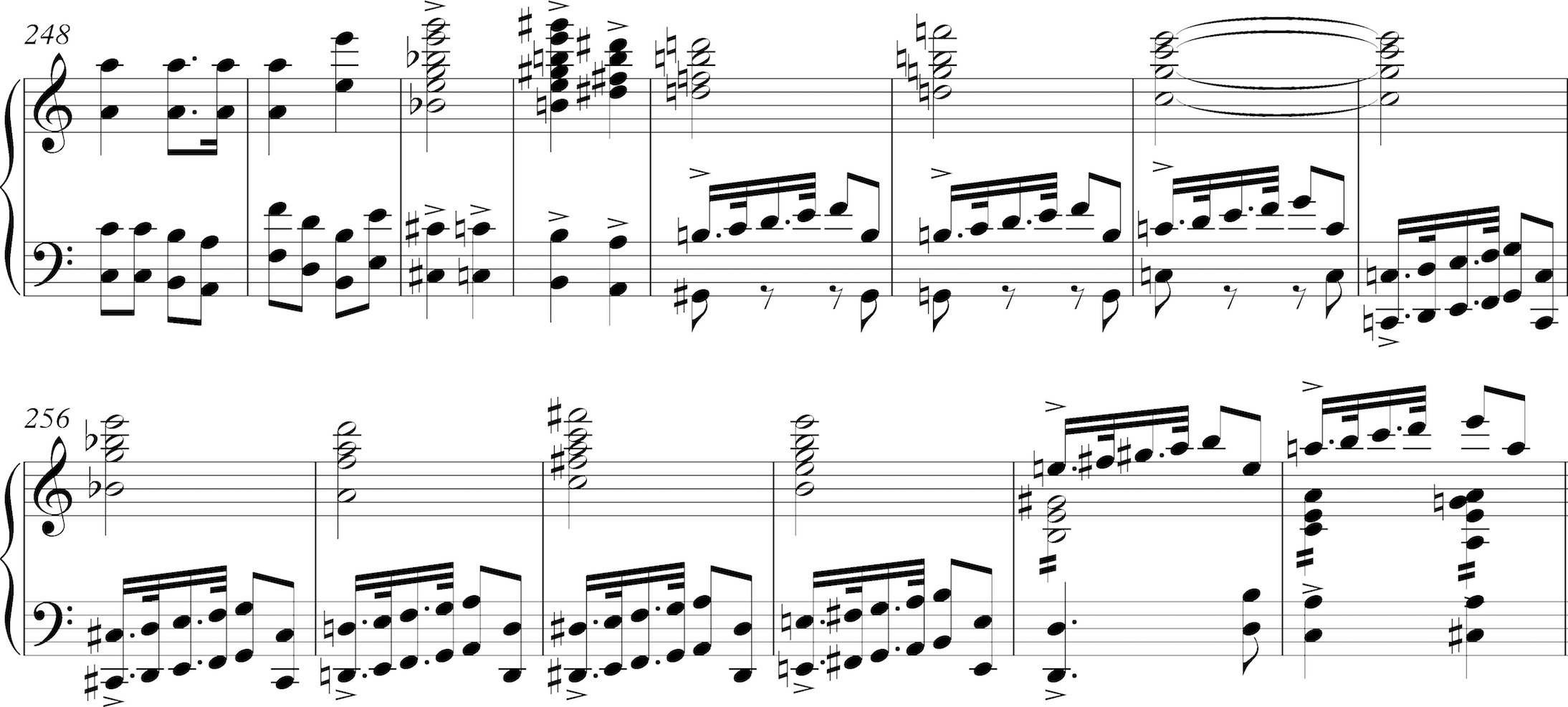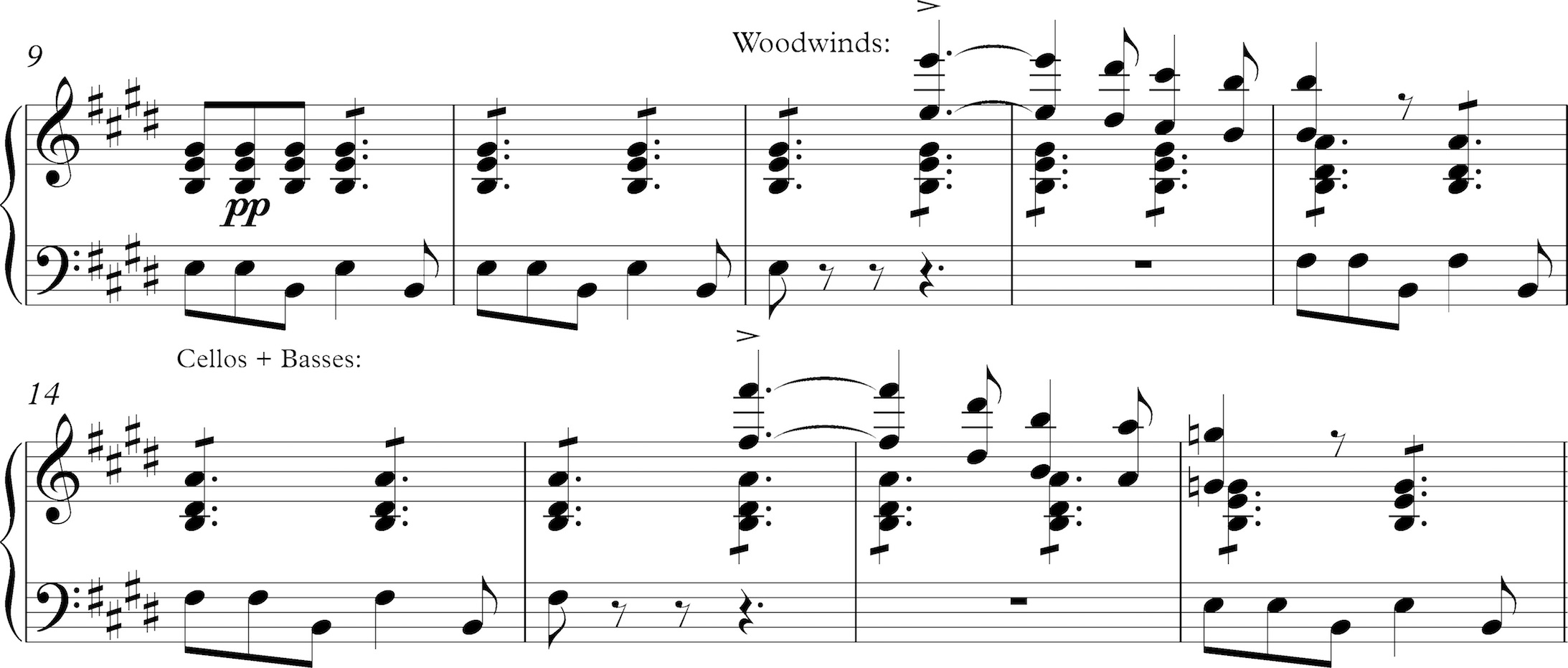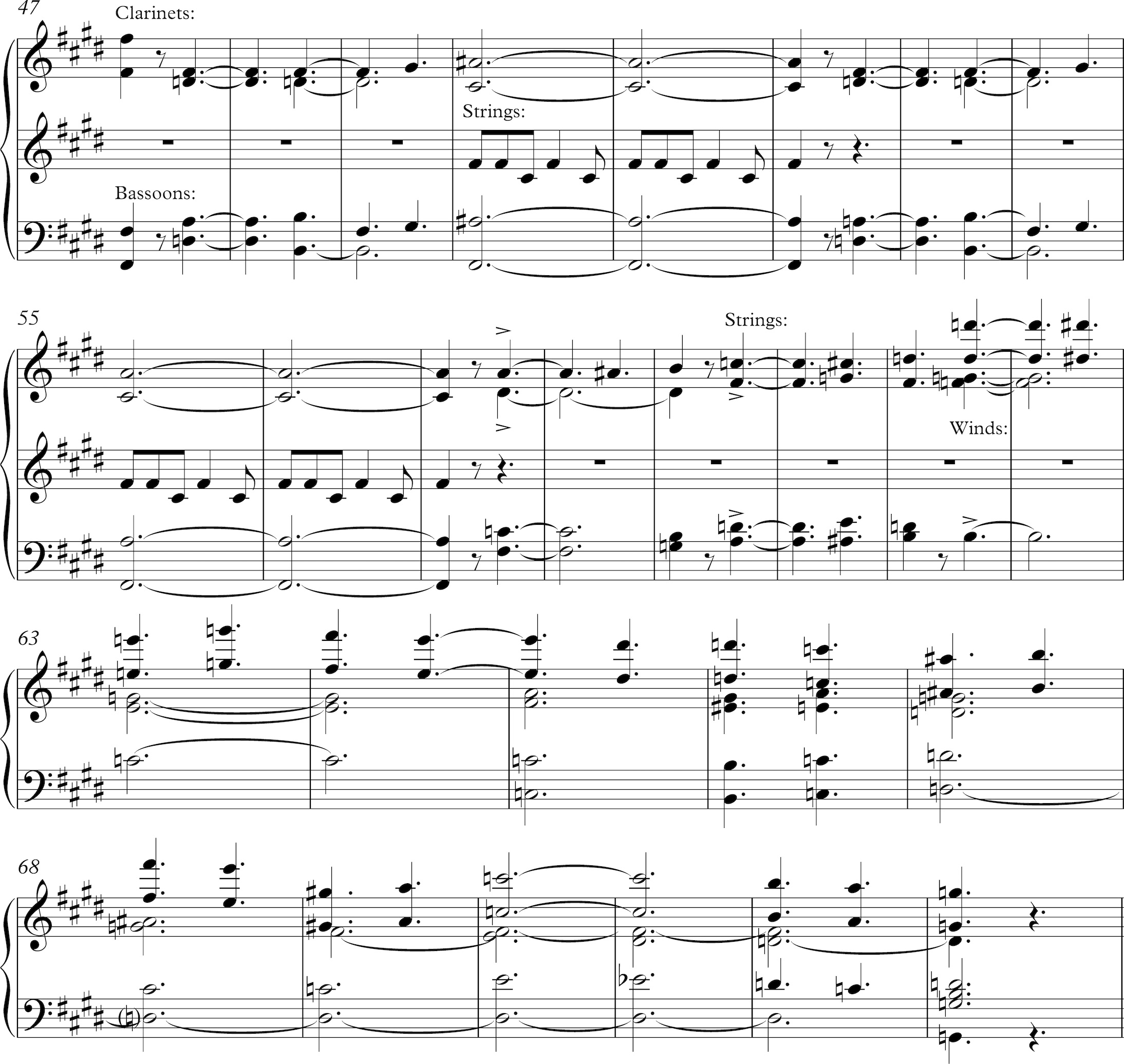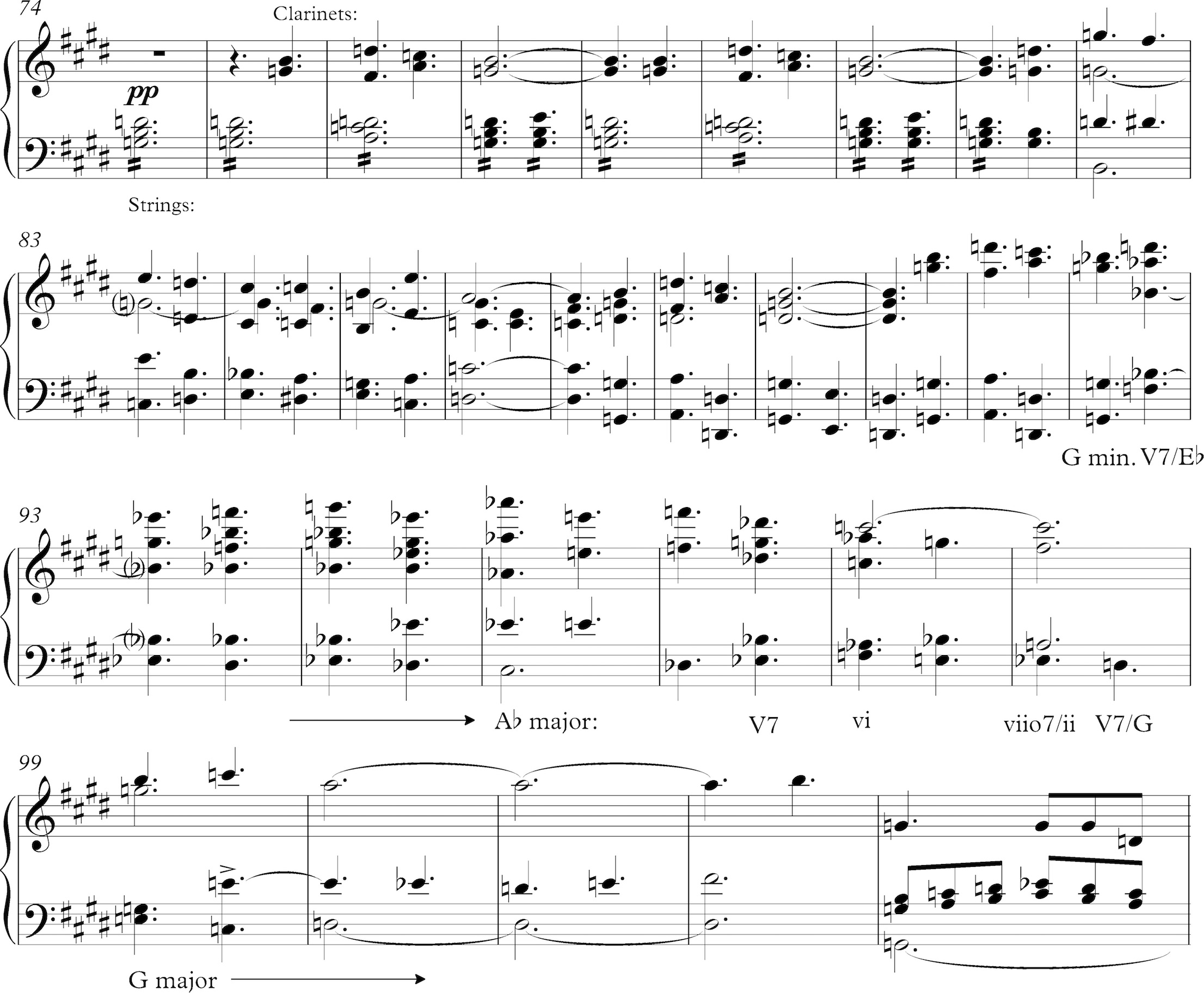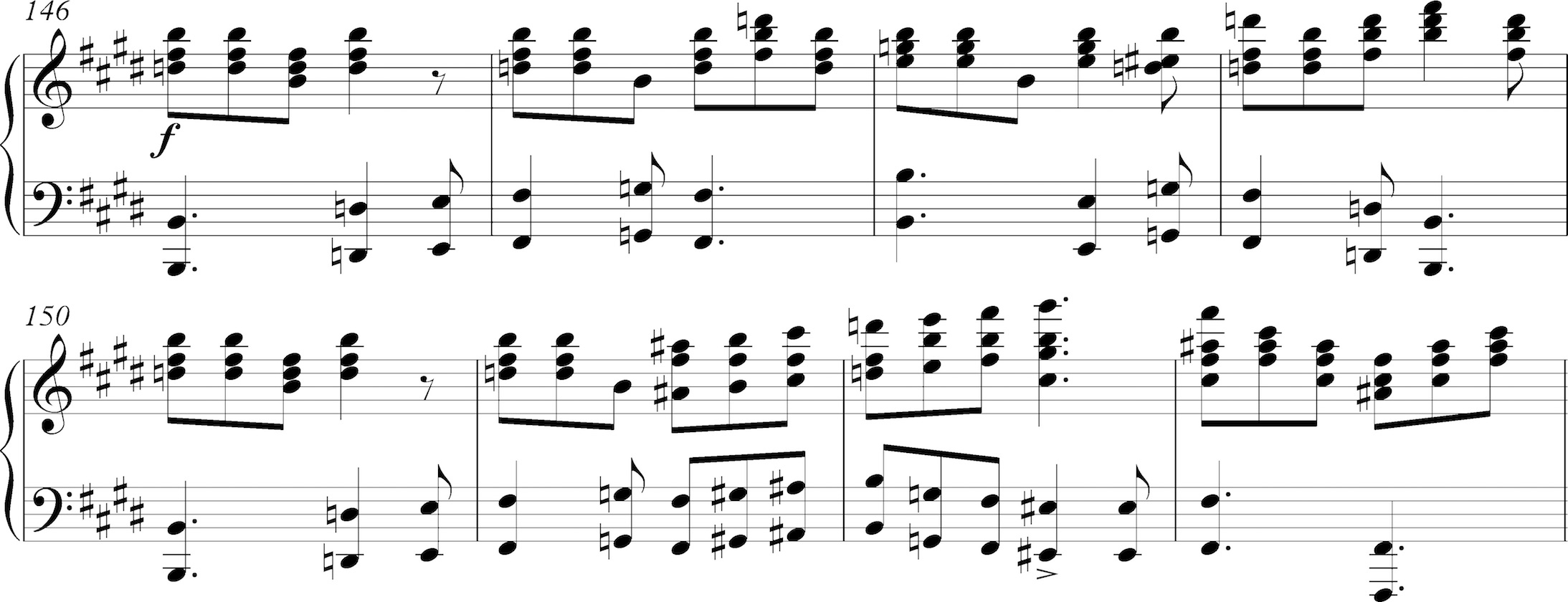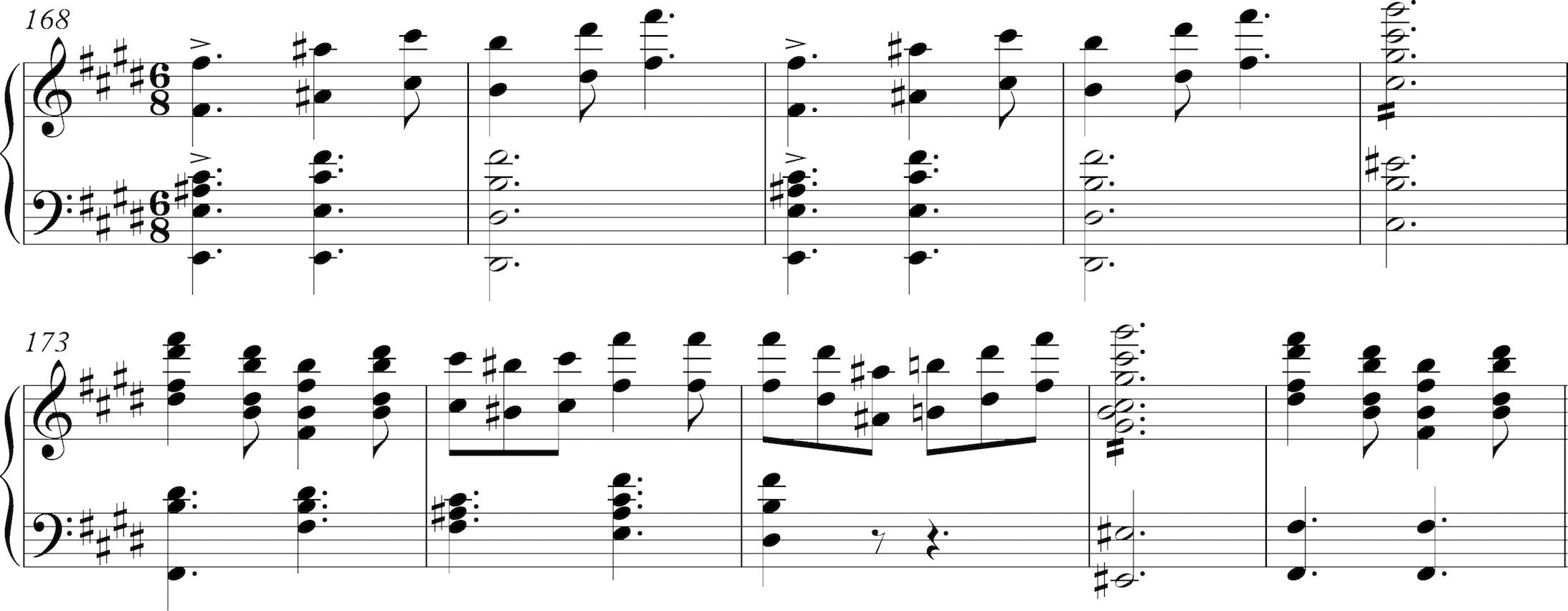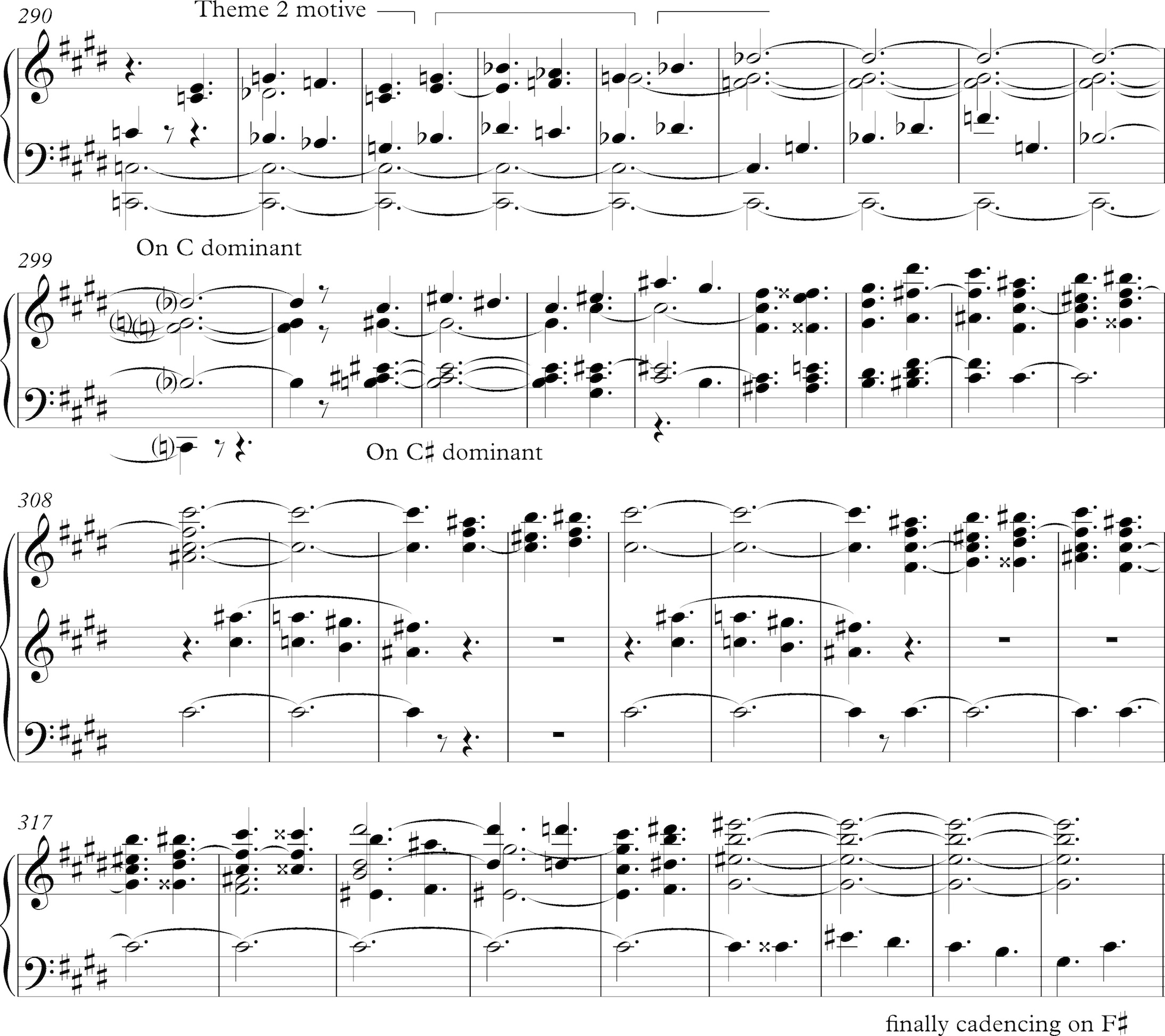George Frederick Bristow: Symphony No. 4 in E minor
Op. 50, "Arcadian" (1872)
Analysis by Kyle Gann
All score reductions by the author
This work is licensed under a Creative Commons Attribution-Noncommercial 3.0 License.Orchestral score of the Symphony (transcribed from the manuscript)
Recording:
First movement
Second movement
Third movement
Fourth movementI think of George Frederick Bristow (1825-1898) as a median figure in 19th-century American music. Unlike John Knowles Paine and George Whitefield Chadwick, he did not study in Europe, and he sometimes devoted his music to specifically American subject matter. Unlike the "Americanists" Anthony Philip Heinrich, William Henry Fry, and Louis Moreau Gottschalk, he hewed close to European and particularly German formal conventions in his music. Of Bristow's five symphonies only three - the Second in d (1853), Third in f# (1858), and Fourth - have been recorded. The First is a Sinfonia in Eb (1848), while the ambitious Niagara Symphony for chorus and orchestra (1893) remains unheard by modern audiences. I find the Arcadian the most convincing of Bristow's recorded symphonies, and find in it a greater simplicity and melodic memorability than in similar works by the German-trained and somewhat more academic Chadwick and Paine.
The first three movements of this symphony were taken from the instrumental movements of Bristow's oratorio The Pioneer; indeed, on the score of the symphony the title The Pioneer is crossed out and replaced with "Arcadian."
An unfortunate note about the 1967 Karl Krueger recording of this piece: someone made three cuts in Bristow's score for this recording, so that just over a third of the first and last movements are omitted. In the first movement measures 506 to 820 are missing, which include the very end of the development and most of the recapitulation. The transition is smooth, moving from a diminished seventh chord to a dominant preparation on E major. Since the main theme, 2nd theme, and transitional theme all appear in the development (though transposed), I suppose it made musical sense, although the crucial second viola solo that opens the recapitulation is omitted. The last movement is missing mm. 370-507 (the entire recapitulation) and mm. 522-617 (the bulk of the coda). The live recording linked to above, however, by Leon Botstein and The Orchestra Now, is the entire work, never before heard on record before 2022.
First movement: Allegro Appassionata, "Emigrants' Journey Across the Plains"
Exposition -- mm. 1-287
First theme (viola solo) -- mm. 1-19
Transitional theme -- mm. 20-61
First theme in orchestra in e -- mm. 62-80
Transition on 2nd theme (c#) -- mm. 81-111
First theme in a (transition) -- mm. 112-148
Second theme in G -- mm. 149-202
Transition on 2nd theme -- mm. 203-231
Closing theme in C, return to G -- mm. 232-271
Cadential theme -- mm. 272-287Development -- mm. 288-540
Transition w first theme in c -- mm. 288-321
Main theme in Ab/g# -- mm. 322-339
Transitional theme in A -- mm. 340-349
Chords in pairs over drone mm. 350-375
Second theme in Bb maj/min -- mm. 376-393
Bass evocations of main theme -- mm. 394-405
First theme in Gb/f#, closing theme -- mm. 406-437
Cadences on G -- mm. 438-447
Echoes of 2nd theme in Ab -- mm. 448-485
Motives of main theme -- mm. 486-505
Descending chromatic scales -- mm. 506-516
Solo viola transition to recap -- mm. 517-540Recapitulation -- mm. 541-836
First theme (solo viola) -- mm. 541-559
Transitional theme -- mm. 560-625
Second theme in E -- mm. 626-715
1st theme reference in A maj/min -- mm. 716-723
New material -- mm. 724-795
Closing theme material -- mm. 824-836Coda -- mm. 837-868
It has become commonplace to describe Bristow's style as similar to that of Mendelssohn, but I find Beethoven far the greater influence, and this symphony in particular seems a response to Beethoven's Eroica, with its long passages of transition, its pounding tutti chords, its love of hemiola, and its leisurely building-up and dissipating of orchestral sonorities. This first movement, in fact, clocks in at just under twenty minutes, slightly longer than that of the Eroica, whose length was something of a scandal for its time.
The theme of the pioneer seems to be referred to here in the unusual device of opening with the main theme played by a solo viola, which will return twice more later in the movement.
Though the pairing of two half-steps isn't particularly emphasized in the theme, it is the combination of B-C and E-D# (marked with brackets) that will turn out to be motivically significant for the entire work. This is a Beethovenian motive, of course, and one that played a large role in Beethoven's late string quartets, which Bristow, as a virtuoso violinist, had probably played at some time. In fact, Beethoven's Op. 131 Quartet in C# minor, which opens with just that pitch complex (G# B# C# A), has a series of themes determined by how far apart the pairs of half-steps are in their scales. Bristow does something similar with the themes of this symphony, and it seems probable that Op. 131 was a model for him.
The transitional theme that follows at m. 22 begins as seemingly as a lyrical continuation taken over by the violins, but it is interrupted by an Eroica-like motto repeated with 16th-note runs in between, and lending itself to easy modulation.
Here the bass simply descends from E to D to C, bringing the third motto to C major. The passage from mm. 40 to 61 plays around with the main theme motives through diminished seventh chords, finally settling on a long-repeating B-C motive that, at m. 62, finally breaks into the orchestra's complete statement of the opening theme. None of this material from m. 40 up until m. 111 will be repeated in the recapitulation.
What Bristow does next is unconventional and intriguing. The main theme's final cadence, headed for E minor, ends deceptively in C# major (m. 80), in which key he gives an anticipation of the upcoming subordinate theme, though not in its exact form; the phrases that will be the basis for that theme are marked with brackets (and will figure in the last movement as well). And since the subordinate key will be G major, this C# major is as harmonically far away from it as he could get. The second theme will finally appear in G major, then in the development in Bb major/minor, and finally in the recapitulation in E major, so he seemed to feel a need to state it in all four keys of a diminished triad.
Under the second bracket, one sees the A#-G# and F#-E#, the paired seconds which are the essence of the theme. In this theme the seconds can be either major or minor, but Bristow exits this section via a transition in which the minor seconds of the main theme (transposed to A as A-G# and F-E) are pounded out for emphasis.
At m. 108 we reach material that will reappear in the recap (at m. 596). The music reaches a modulating form of the theme in A minor.
Diminished seventh chords bring us to a D as dominant, through a repeating melodic sequence of half-steps G-F#, Eb-D, and the music pauses after a half-cadence through those four pitches. In mm. 138-150 the winds pause for a leisurely and quiet transition on a D dominant, and in their last measure they are charmingly joined by the strings to introduce the subordinate theme in G major. Notice that the second group of phrases continues the idea of two half-steps (bracketed), C-B and A-G# - only a minor third apart rather than a major third as has been the case up until now.
The subordinate theme area is quite long:
Transition to the theme: mm. 139-149
Subordinate theme: mm. 150-203
Transition away from the theme: mm. 204-231but it is beautifully inflected between major and minor and keeps generating new but related variations. As the transition to the theme emphasized G-F#-Eb-D, the transition back will fixate on two other half-steps: B-Bb-G-Ab (m. 220ff). The music builds, leaping to ever higher downward step motives, until we reach a grand theme changing from major to minor, whose triadic movement might remind us a little more of the Eroica than of Bristow's main theme.
From here to measure 287 the music is a climax of sliding diminished seventh chords and arpeggios leading to a dominant preparation for G and several syncopated cadential formulas. At the penultimate moment, m. 280, the music suddenly shifts toward a deceptively fortissimo Eb-major, but lands safely back in G major after its descent.
The development opens moodily (m. 288), as the tonic G turns into the beginning of the main theme in C minor; as it is elaborated the pitches C-B and Ab-G are all that is left of it. Then the orchestra bursts into a phrase from the theme in Ab major, repeating it immediately in G# minor (this passage will reappear).
Diminished chords take us to the key of A major, where the Eroica-like part of the transitional theme recurs at m. 340. A long stream of twice-repeated chords over a D drone (mm. 349-376) decrescendos to quiet, and then the second theme, now in the woodwinds, enters in Bb and then changes to minor, as though the major/minor switching idea is becoming a habit. An extension of the theme in the low strings bring us to the above major/minor version played in Gb and F# (mm. 406-413), and then the closing theme reprised in D (m. 414). This is developed through various harmonies, until from mm. 430 to 446 a long dominant preparation leads us in decrescendo to G.
Except that when we reach that G it is harmonized as an Eb dominant: the change threatened at the end of the exposition now recurs as modulation. Pianissimo sustained take us though Ab major and F minor to Db major as vestiges of the second theme swirl around.
It is Bristow's habit to change dynamics through long, gradual crescendos and decrescendos, but having lulled us to sleep in a foreign key, for once he indulges, at m. 486, a subito forte on a dominant seventh on A - A7 being the German sixth of Db. The third theme in D returns, but only for a moment, as from mm. 506 to 514 (and this is where the Krueger recording cuts some six minutes) the orchestra slides down a chromatic scale in decrescendo. At m. 517, over a soft B drone, our old pioneer the solo viola enters, for a long time simply playing off-beat dotted-half notes as though calculating whether he's got it in him to start up the theme again. Meanwhile two clarinets move back and forth between two thirds, just as much of the orchestra did when the strings were mulling over B and C in mm. 51-59; on repeated listenings the repetition is amusing.
With the upbeat to m. 542 the recapitulation officially begins, as the viola restarts the main theme. This time the old pioneer seems to have family with him, for the strings pluck the off-beats as in an darkly apprehensive waltz. The strings begin the transitional theme (m. 562) a third higher in the scale than before, and by a phrase extension effect an easy modulation to G major for the pounding chords. The exposition and recapitulation can be correlated as follows:
Mm. Exposition Both Recapitulation Mm. 1-21 Main theme (viola) 541-561 22-39 Transitional theme 562-583 40-61 Main theme motives 62-80 Main theme in orch. 81-88 2nd theme in c# 89-111 half-step motives tutti chords 584-599 112-138 Main theme modulating 600-626 139-149 Transition to 2nd theme 627-637 150-203 2nd theme 638-691 204-231 Transition to climax 692-715 232-243 Main theme in maj/min 716-723 New material 724-795 244-287 Climax 796-836 The orchestral statement of the main theme is of course omitted from the recap as redundant, nor is the curious anticipation of the subordinate theme in C# brought back, as by now its point has abundantly been made. Instead the recap replaces these with the Eroica-like chords from mm. 350-375 in the development. The modulating form of the main theme comes back in both, and the second theme is restated in the tonic E major. The music crescendos up to the major/minor form of the theme in A, and then Bristow does something remarkable. Instead of waiting until the coda to add some new, freely-composed material, as was classical practice, he goes into seventy-two measures of ecstatic melody containing new ideas not heard earlier.
First there is a joyous C-major melody in thirds as the bass leaps by octaves.
More strangely, the music then quiets down to a harmonically ambiguous trio for flute and clarinets as the cellos rock between B and C (mm. 744-753); and then at m. 754 the violins take off on a leisurely fantasia around motives of the first (and possibly second) themes.
At m. 795 the recapitulation picks up where the exposition was at m. 244 and follows it closely (transposed from G back to E, of course) to m. 836. Where, in the exposition, G major feinted to Eb just before the final cadence, this E major goes to a diminished seventh on A# and stops on it. Once again the pioneering violist raises his weary bow, to begin the coda on his theme. Bristow is rarely content with simple repetition, though, and this time he inserts a complication, an apparent turn to G# minor at m. 846, that actually stems from the voice-leading to a V/iv. It is an elegant final composerly flourish.
Within the long final E minor chord, the cellos and second violins repeat a lonely phrase of the main theme.
Second movement, Andante religioso, "Halt on the Prairie"
The second movement Adagio contains some of the symphony's finest moments. It, too, is in sonata form, but the development section is so brief and so smoothly continued from the exposition as to suggest the common "Sonata without development" slow-movement form. In each half the first thematic area is in 4/4 meter and the second in 12/8. The following chart correlates the measures in the exposition with the parallel passages in the recapitulation.
4/4 meter Exposition Recapitulation mm. 1-16 Theme A mm. 70-85 mm. 17-24 Chorale theme mm. 86-93 12/8 meter mm. 25-30 Bridge melody mm. 94-99 mm. 31-35 Transition mm. 100-104 mm. 36-47 in G Theme D mm. 105-116 in B mm. 48-69 Different material mm. 117-125 4/4 meter Coda, mm. 125-136 The first thematic area divides into two parts. The first has half the melody in the horn and the second half in the strings. Notice the peculiar F-double-sharp in mm. 6-8: it remains rather enigmatic here, but in the recapitulation the strings will pick up that F-double-sharp (instead of F# as here) as part of a D# dominant seventh resolving to G# minor, but the original melody is quickly resumed, though in the winds rather than in the strings. This peculiar moment of stasis on a D# major triad seems to be setting the stage for something, and I think it does.
After a drawn-out half cadence, the lower brass play "Tallis's Evening Hymn" ("All praise to Thee, my God, this night"), a hymn based on an old tune by Thomas Tallis (1505-1585) that others later provided words for, and which was popular in 19th-century America. These brass players are clearly meant to represent the pioneers paused for the night on the prairie, singing a hymn before or after dinner as thanks for their safe journey so far. Bristow will later put the hymn's elements to good use.
The melody that opens the section in 12/8 has the valedictory flavor of a closing theme, but it is brief, and soon leads into an orchestral climax that will effect the key change.
This melody quickly (at m. 31) leads to an F-natural dominant seventh, which changes course into C major, then a diminished seventh on C# leading to an apparent Eb dominant which is actually a German sixth chord in the key of G - which is how it resolves, into the movement's real second theme in the subordinate key of G (and subordinate key for the first and fourth movements as well). For comparison I also show the return of this passage in the recapitulation, where instead it goes into E major and then a G dominant seventh, which is actually the (misspelled) German sixth of B; this is how Bristow returns his second theme to the tonic the second time around. This use of reversed dominant sevenths and German sixths, from B to Eb7 to G and from B to G7 to B, is quite familiar to any student of the music of Schubert, Brahms, and other Romantics. I make this rather boring technical point merely to emphasize how comfortable Bristow was using the same tricks of the trade as his European contemporaries.
The languid subordinate theme follows (m. 36), delightfully dotted with staccato woodwind chords on the off-beats. Notice the leap up from G to E and Eb in m. 38; he repeats it at m. 42 only leaping up to B and Bb as a way to turn the theme toward the dominant key. Notice in mm. 37-38 that B-C and F#-G are the paired half-steps this melody is based on.
In mm. 45-47 the music modulates to the dominant D's relative minor B, and the subordinate theme is played in the dominant of that key, F# (mm. 48-51). Nevertheless, a following A dominant seventh brings the music back to G major, and another modulation (mm. 58-59) brings the harmony back to B major. In what seems a common orchestral platitude at first, the orchestra pounds on a unison B - which, in retrospect, turns out to be the beginning of the chorale theme from the first section, its second phrase now clothed in a meltingly nostalgic harmonic sequence through the circle of fifths. It's clever that the stolid tune that opened the chorale now doubles as a cadential gesture. The motive is then repeated on F#, as dominant preparation for the recapitulation.
A quiet repetition of this phrase (mm. 67-69) brings the music to a dominant of B major.
The recap's first theme is almost verbatim taken over from the exposition, though with one harmonic deviation already noted and some changes in instrumentation. It is the new version of the chorale melody that is perhaps this movement's happiest feature. Once again the tune is played by the horn, but instead of an ascetic chorale setting, now the strings provide a cheery pizzicato accompaniment, while the first violins whirl away overhead in athletic triplet 16th-notes. The atmosphere could not be more transformed - it is as though the unadorned, homespun hymn came back accompanied by fireworks and fireflies.
The 12/8 section in the recapitulation follows its partner in the exposition very closely up until the modulation that prepares to state the subordinate theme in the tonic key, shown above. Not until m. 117 does the recapitulation depart from earlier material, spinning motives from the subordinate melody for an eight-measure close. Interestingly, its climax once again uses the F-double-sharp to rise to a G# minor triad, as had happened at m. 78. The quiet coda, lasting eleven measures, is a chorale in the clarinets and bassoons over an ostinato of alternating B's and A#'s in the lower strings - quite reminiscent of passages in the first movement in which the bass alternated between B and C.
Third movement: Allegro ma non tanto, "Indian War Dance and Attack by Indians"
A section -- mm. 1-110
Introduction -- mm. 1-12
Theme A -- mm. 13-40
Theme B -- mm. 41-56
Theme A varied -- mm. 57-72
Theme B -- mm. 73-84
Theme A -- mm. 85-110Trio -- mm. 111-172
A section -- mm. 173-296
Retransition -- mm. 173-200
Intro-Theme A -- mm. 201-237
Coda -- mm. 238-296
Final Theme A -- mm. 274-281Probably as part of his "pioneer" theme for this symphony, Bristow ill-advisedly titled the scherzo "Indian War Dance." I say ill-advisedly not merely in terms of today's politically correct conventions, which would be anachronistic in terms of 1872, but because Bristow clearly had no intention of evoking indigenous American music; the melody sounds perhaps more Scottish than anything, and would sound at home in Edvard Grieg's Peer Gynt Suite. One imagines these noble indigenous warriors wearing kilts and hoisting mugs of ale.
The form is an A section alternating two themes; a trio with one theme in calm D major; and a final A section marked by a long retransition, a recurrence of the introduction and main theme, and a long coda. The introduction to the piece emphasizes the half-step motive, both C-B and D#-E at the beginning, but later F-E and D#-E.
Theme A's accompaniment of pounding triads is the movement's only reference (and hardly a convincing one) to indigenous music. The theme is repeated a few times with denouements of downward-flowing chromatic lines.
The second theme, as a glance reveals, is particularly square and lacking in melodic interest.
The return of the main theme is modified to modulate a bit, and then the second and main themes are repeated.
The Trio, or B section, is a long, sylvan melody in the trumpet and trombones, with a repetitive and not very imaginative accompaniment. It and its subsequent phrase are somewhat overly repeated with little tension or variety. The D-Eb-Bb-A in mm. 126-128 might be taken as another manifestation of the thematic combination of two half-steps.
The return of the introduction and main theme are gradually approached by a long retransition, and the coda that follows is rather predictably conventional given the idiom. The retransition, traveling through many a diminished seventh chord, starts by alternating the chromatic scale runs of the B theme with phrases of the A theme. The introduction to the movement (approached by a rather clumsy F# diminished seventh - mm. 197-200 - leading to A minor) is then repeated, and the drumbeat that underlies the main theme is greatly amplified with timpani, cymbals, and triangle - this is clearly the attack of the Indians on the poor pioneers (who are in the process of stealing their land). Around m. 248 there is a passage whose modulations and major triads suggest that the tide of battle is turning.
The final cadence, though is trenchantly fierce.
Overall this movement contains few of the sparks of imagination or beauty so common in the other three movements, and I consider its failure to live up to the level of the rest of the work the Arcadian Symphony's greatest flaw.
Fourth movement: Allegro con spirito, "Arrival at the New Home, Rustic Festivities, and Dancing"
Exposition -- mm. 1-215
Intro -- mm. 1-8
First theme -- mm. 9-18
Transitional theme -- mm. 19-46
Anticipation of second theme -- mm. 47-72
Second theme -- mm. 73-102
Transitional area -- mm. 103-145
Closing theme -- mm. 146-195
Retransition -- mm. 196-215Development -- mm. 216-369
Recap of introduction -- mm. 216-223
First theme developed -- mm. 224-243
Transitional theme developed -- mm. 244-263
Closing theme developed -- mm. 264-289
Second theme developed -- mm. 290-341
Closing theme developed -- mm. 342-369Recapitulation -- mm. 370-507
Recap of introduction -- mm. 370-377
Theme A -- mm. 378-393
Transitional theme -- mm. 396-421
Theme B -- mm. 422-451
Transitional area -- mm. 452-475
Buildup to Presto -- mm. 476-507Coda - Presto -- mm. 508-626
The fourth movement, "Arrival at the New Home, Rustic Festivities, and Dancing," does not all sound as carelessly joyful as its title suggests, but it does start with a pulsing motive of perfect fourths and a burst of exhilaration from the strings.
The movement takes some curious departures from usual sonata-allegro form, which I think Bristow must have been brave to write, given how closely American works were compared to their European models. What occupies the place of the first theme, echoing between cellos and high woodwinds, is so brief, and modulates so soon, that it hardly fulfills the typical function.
Instead, it turns from that E minor close into a tutti orchestra return of the fourths motive in C major, which, being essentially the German sixth of E, slips back into the home key rather handily. The music bounces to a cadence on F#, which sounds, in this context likely to become the dominant of B, which is likely to be the second theme's key. Instead, the F# major turns minor, and a subsequent F# diminished seventh turns toward G major as the second key, though with so many secondary dominants and misdirections that it is a long, soft landing indeed.
The second theme continues much in this pastoral vein, as though merely a continuation of the transition. Like the woodwind part of the first theme, the second theme also begins after its downbeat (m. 73? 75?), somewhat as an afterthought, and charmingly. Its first phrase stays within G major, but the second veers rather alarmingly into Ab major as though it, too, like the first theme, didn't care much for its initial key, but over a long sweep it manages to slide back into G major and cadence.
In this movement Bristow has a quick and easy modulation device: he can move his fourths motive anywhere in the scale he wants, with some woodwind motives from the second theme in-between as lubricant.
By repositioning this motive Bristow goes from G major to E minor and finally to F# major, which is now the dominant of B that we'd expected earlier. Plunging into the minor mode, though, this brings us a new, punchy theme in the bass at m. 146, a little reminiscent of the first movement, and one that suggests the celebrating pioneers may be well into their libations (or perhaps merely piling up logs for their new homes).
However, its triadic motive is convenient for modulations, and at m. 168 the violins take it into B major, where it takes on a more resolving tone, as though this were the real closing theme and the previous theme just the set up for it.
The aftermath finished off the exposition in triumph, and a nicely harmonized tune in the oboe returns us to E major - a seeming retransition, as though the exposition were going to be repeated, which it isn't.
Nevertheless, the development does start off, oddly enough, by repeating the opening in the original key. The first theme arrives and lasts longer than it did before, undergoing some development. The transitional material is developed from mm. 244-263, and at m. 264 Bristow takes the first phrase of the closing theme as a modulating ostinato, repeating it through various harmonies and keys. By m. 280 it has reached F minor, and the music settles down to a drone on C. The next passage is remarkable; it opens with motives from the second theme, and is clearly related to it, but quite rewritten. At m. 300 the C dominant simply moves to a C# dominant as the woodwinds take it over, and with the same lingering hesitation as before, with sliding chromatic sixths added in the strings that are quite lovely, the music slowly hones in on F# major.
The coda to this little section is delightful: three times it starts from the fourths motive (adding the two half-steps C#-D and E#-F#, the symphony's central motive) and then slides down in alternating major and diminished triads, an octave lower with each repetition.
The music takes up the closing theme motive again and modulates it from F# to B to E, and after a dominant preparation we're in the recapitulation. (Keep in mind, the entire recapitulation and the bulk of the following coda are omitted from the Karl Krueger recording.)
In the recapitulation the first theme (mm. 378-393) is longer and modulates to B rather than C as in the exposition. Much transitional material is skipped (as in the first movement), and the anticipation of the second theme starts in B major/minor rather than F#. Oddly, the transition cadences at m. 422 in C major, and the second theme is heard in that key - including its digression into Db, parallel to the original second theme veering from G to Ab. The second theme is never heard in the tonic key of the movement, nor does any of the closing theme material appear in the recapitulation - curious departures from sonata conventions.
A presto section begins at m. 508, but one is tempted to say that the coda actually begins at m. 476, since Bristow introduces a new theme, though a brief and simple one, in the horns, with trumpet fanfare. As in the first movement, chromatically moving minor thirds lead to a dominant preparation, with much emphasis in the lower brass on the thematic dyads C-B and E-D#. The following presto is the whirlwind of celebratory triplets one would expect to close so long a symphony, but there are some surprises. At m. 528 the music edges up to Ab major for a bass melody whose rhythm (I'm thinking of the 16th-notes) seems to refer briefly to the close of the first movement, but which develops the closing theme.
At m. 548 this entire figure is reiterated in C major, and at m. 568 it seems to reappear in Db major, though that material is somewhat simpler. The orchestral bombast slips through diminished seventh chords back to E major at m. 580. The extended denouement alternates the tonic chord with the major and minor subdominants, and indeed - over a dramatic timpani roll, the minor subdominant is the last chord we hear before the concluding E. The ending is in E, but not unambiguously in E major.
I would advance this symphony as possibly the best American symphony written before Charles Ives's First (though I don't have Bristow's Fifth for comparison). Bristow's strength lies not in his thematic material, which is unexceptional, but in that he was a born sonata-allegro composer. He can expertly modulate within a theme, and even signal to the listener whether the modulation is only momentary or more structural. He can delay a definitive cadence with the best of Wagnerians. He doesn't like so much to develop motives as to repeat themes and bend them, sometimes exquisitely, to different purposes each time. One of his quirks is that he repeats so much of his high-profile expositional material in the development section that (in the first and last movements) by the time the recap has passed one feels like one's heard everything three times; this surely accounts for the temptation to cut his music. Yet he seems to be the rare composer who writes more comfortably in sonata form than he does in simpler forms. The only moment in the third movement that sounds developmental is the tide-turning battle just before the end, and it is the most convincing part of the movement.
Bristow's symphonic ambitions are large. One might say that this mammoth first movement attempted a Mahlerian breadth with only a Beethovenian number of themes, so that much of its length is taken up by transitions and long, modulating chord progressions buoyed by repeated motives. He also had a Beethovenian sense that masses of orchestral tone can be so overwhelming that crescendos need to be built up slowly and decrescendos released just as slowly, so the music ebbs and swells with a leisureliness that might try the patience of listeners more inured to modern disruptions. Above all, it sounds like a piece written by someone who spent his life sitting in the orchestra and absorbing the sonorities and the style.
Copyright 2019 Kyle Gann
Return to American Symphonies
Return to the home page
